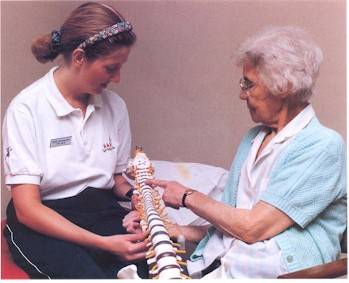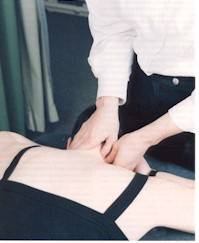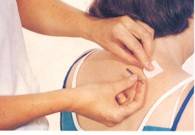Positive Health Online
Your Country

Physiotherapy Today
listed in physiotherapy, originally published in issue 23 - November 1997
What do Physiotherapists do?
This is a question which is often asked and it would be true to say that there are different perceptions as to what a physiotherapist actually does and in what areas of patient care they are involved.
Physiotherapy today is defined as:
"A systematic method of assessing musculoskeletal, cardiovascular, respiratory and neurological disorders of function including pain and those of psychosomatic origin and of dealing with or preventing those problems by natural methods based essentially on movement, manual therapy and physical agencies."[1]

A physiotherapist (left) showing a patient a model of the spine in order to
explain her treatment and the cause of the problem presented.
All chartered physiotherapists have either a graduate diploma or honours degree. The curriculum of these courses comprehensively addresses the theoretical as well as the practical aspects of: Anatomy and Physiology, ergonomics, movement, electro-mechanics and psychology.
Specific techniques such as manual mobilisation of joints are now included in the undergraduate syllabus and some universities have electives in complementary therapy e.g. Acupuncture in the final year of study.
The graduate usually consolidates the large area of knowledge acquired as an undergraduate in the next 2 years, by working in hospital gaining experience in the different specialities. Some will remain within the hospital service and others go into private practice.
Many will opt to specialise in a particular areas of work e.g. Orthopaedics, manual therapy, neurology, respiration, sports injuries.
Within the Chartered Society of Physiotherapists there are Clinical Interest Groups, which provide a framework of continuing professional training within these specialities. e.g. Manipulation Association of Chartered Physiotherapists (MACP), Acupuncture Association of Chartered Physiotherapists (AACP), Association of Chartered Physiotherapists in Sports Medicine (ACPSM).

Neck Mobilisation

Acupuncture
A physiotherapist has clinical independence.
A patient can either be referred by a medical practitioner or other health professional or simply self-refer. There is always, however, a close liaison between the medical practitioner and the physiotherapist.
There must also be a close understanding between patient and physiotherapist as a holistic approach to treatment is not possible without full knowledge of lifestyle, aspirations and specific problems which are present as a result of the presenting condition.
This means that a thorough assessment of the patient, including medical/social history, lifestyle and physical examination have to be undertaken, a clinical diagnosis made and the recommended course of treatment agreed with the patient.
The nature of the work undertaken varies greatly with the presenting condition. Treatment following a Stroke may be extended over many months and involve close liaison with other health professionals such as Speech and Language therapists and Occupational therapists. A simple musculo-skeletal problem, properly managed, could be resolved in 1–6 treatments.
It would not be possible in one article to cover all the aspects of clinical practice undertaken by physiotherapists and there are still many areas of practice whose efficacy is even now being evaluated. Research into the effectiveness of physiotherapy practice is fraught with difficulties, not least, that of the placebo effect.
Physiotherapists are encouraged to constantly monitor what they do in relation to presenting problems and outcomes. This means that there is a continual updating and learning process. There are many modalities which I learnt 30 years ago, which are now no longer in current use having been superseded by more effective treatments.
The basic process of examination and treatment, however, remains the same.
There are 4 classic headings under which I'm sure most health professionals work.
Look, Listen, Ask, Palpate.
Looking
involves assessment of posture, observing asymmetry, range of movement and any changes in the skin.
Listening
involves finding out how the problem arose. Allowing the patient to tell in his/her own words how the problem started and expressing their own fears about their problem.
Asking
This is the 'detective' part of history taking and involves finding out what the patient can or cannot do, when is the problem at its worst and what activity does he/she want to return to. What drugs are being taken. Establishing any recent change in job, lifestyle etc can hold the clue to the present situation.
Palpating
involves feeling the temperature and pliability of the skin and the subcutaneous tissues. The state of the muscles is significant; are they tight, flaccid or 'knotted'? The joints are tested for active movement and for accessory range.
Palpating all the tissues systematically will enable the treatment to be focused to those areas where abnormalities are identified and therefore it will be more effective.
Having gone through all the above stages of examination a clinical diagnosis is made.
From this point onwards there can be a great diversity in the treatment programme, which depends mainly on the conven- tionally acquired skills of using manual techniques, heat/cold, laser, Ultra-Sound, Interferential and Pulsed Shortwave Diathermy. Many physiotherapists have continued their professional training by studying complementary therapies such as acupuncture, reflextherapy and aromatherapy.
These skills are incorporated into the treatment programme as appropriate. All the above techniques are at the fingertips so to speak of the physiotherapist as a means to address the problem presented.
My own speciality is in musculoskeletal problems and includes the practice of acupuncture. This will be a personal account of what I do. To illustrate this point some case histories of patients follow.
1 Neck Pain.
Male (aged 32) A tall patient (over 6ft) who was referred to me because of acute cervical spine pain. In taking his history I asked if there was any thing that had altered in his daily life in the past 6 months. The pain had slowly become a problem over the past 4 months.
At the first treatment he could not remember anything significant. I treated him using manual techniques, which gave him immediate improvement in movement and alleviation of pain. He returned the following week having regressed. I impressed upon him the importance of postural exercises but the improvement still was only temporary. I then went back to my original notes and asked him again about any changes in his lifestyle. 'I got a new company car a few months ago' he said. I went into the car park with him and saw a beautiful Citroen car. There was one serious problem, however, when he sat down in the driver's seat his head was touching the roof. To correct this, he had adjusted the seat to its full extent backwards, which meant that he was having to poke his head forward to see properly out of the windscreen.
There was no way that my treatment was going to help him given that a long period of time every day was spent in this poor postural position. I found a manufacturer who made individual seats for cars which were lower than normal. He was able to persuade his firm to have such a custom built seat fitted and his pain was soon resolved.
2 Tennis Elbow
Female (aged 49) This lady came with a 10 month history of Tennis Elbow. She was a keen tennis player and had been unable to play for 5 months.
She had had 2 hydrocortisone injections, which had given only temporary relief. She had attended an osteopath on six occasions but without any result.
When examined she had local tenderness at the elbow where the Common Extensor Tendon attaches to the lateral epicondyl, an increased lordosis in the cervical spine and tenderness of the right apophysial joints.
This was a problem relating to both the cervical spine and the right elbow, therefore both areas needed addressing.
The patient was shown postural correction exercises,[2] the apophysial joints were mobilised and local and distal acupuncture points were treated with needles. Advice was given to increase the circumference of the handle on her tennis racket. This would alleviate the strain on the tendon at the elbow.
After 4 treatments she was playing tennis again. She still had some discomfort but we both felt that the healing process had started and that the condition would completely resolve in time.
3 Tempero-mandibular (TMJ) joint pain
Female (54) This lady presented with severe right Tempero-mandibular pain of sudden onset 4 months ago. She had an underlying diagnosis of rheumatoid arthritis.
On examination I found no particular problems in her upper cervical spine joints, which can contribute to such pain.
She could only open her mouth to one finger width and was severely compromised as to biting or chewing her food.
A hydrocortisone injection had failed to relieve the situation.
She was very sensitive over the TMJ. While my first choice would have been to use acupuncture to address this problem the local sensitivity precluded using a needle in XIAGUAN (Stomach 7) which is sited over the TMJ.
I decided to use a Transcutaneous Nerve Stimulator, placing one electrode over the TMJ joint and one electrode over the area between the thumb and index finger which includes the acupoint HEGU (Large Intestine [4]). HEGU has a specific effect on facial pain. The frequency was set at 100 Htz and the intensity to the point of patient tolerance. After 20 minutes there was a marked reduction in pain.
The patient was shown how to use the TENS stimulator at home and was shown exercises for her TMJ joints and returned after 3 days.
After using her machine for one day at 3 hourly intervals she had had complete pain relief. She tried for one day without treatment, but the pain returned although with less intensity. She could open her mouth to 2 finger widths.
I then treated her with needles using HEGU and ZUSANLI (Stomach 36). This is a distal point on the Stomach meridian which also has a strong general analgesic effect. The point XIAGUAN was still too tender to treat with a needle.
After a further treatment she was clear of pain and had full mobility in her TMJ.[3]
4 Occipital Headache
Female (46) This lady had a 6 month history of occipital pain. It had been gradual in onset and no exciting cause had been identified. The pain was worse on waking in the morning although her sleep was not disturbed.
On examination: She had an increased cervical lordosis and restriction of right rotation. There was tenderness at the level of the second and third cervical apophysial joints.
Treatment: I used mobilising techniques on the tender joints[4] and local acupuncture.
Advice was given on posture especially in sleeping. She was advised to make herself a 'Butterfly' pillow by tying a ribbon tightly around the centre and to fit the narrow area into her neck before settling down to sleep. This has the effect of restricting tossing and turning while asleep and also gives support in the side lying position. She was also shown how to work the posterior neck muscles in a simple neck bracing exercise which could be done lying in bed before sleeping and on waking in the morning.2
After 3 treatments her symptoms were gone. I impressed upon her the importance of maintaining the butterfly pillow and the postural correction neck bracing exercise.
5 Knee Pain
Male (aged 35) This man had injured his right knee 6 months ago while playing football.
He had recovered after 2 weeks in that the swelling had reduced and he could walk without a limp. He was unable to run and felt as if his knee would give way at any time. He complained of a constant dull ache which was intensified after prolonged walking or standing.
On examination: he had full movement of his knee and hip and his ligaments were not found to be affected. However, his right quadriceps muscle appeared to be reduced in size. Measuring the circumference of his thigh confirmed this impression as it was 20 cms less than that of his left thigh.
The cause of his problem was explained and a plan of graded exercises was worked out. This involved supervision at the clinic by giving increasing weight resistance to the quadriceps during exercise and a daily programme to do at home.
After 2 weeks he had regained his muscle strength and after a graded programme of activity was able to return to play football.
The above case histories illustrate that an essential part of physiotherapy clinical practice, is to involve the patient actively in the healing process. Sometimes this can be difficult, as the prevailing attitude to any 'therapy', is that the therapist 'will make me better and I don't have to do anything'. Merely relieving symptoms is only one part of the treatment process. The other somewhat more difficult part is being able to explain how to maintain the 'gains' achieved through treatment. This may mean giving advice as to how they work, play or doing the housework. Thus the words 'teaching', 'Empathy' and 'rehabilitation' are very important to all physiotherapists.
References
1. Physiotherapy the Orthodox Alternative: Chartered Society of Physiotherapy.
2. Treat your own Neck R. Mackenzie: Spinal Publications. 1990
3. Acupuncture in Clinical Practice N. Ellis. Stanley Thorne 1996
4. Vertebral Manipulation G Maitland Butterworth Heinemann 1986
Comments:
-
No Article Comments available